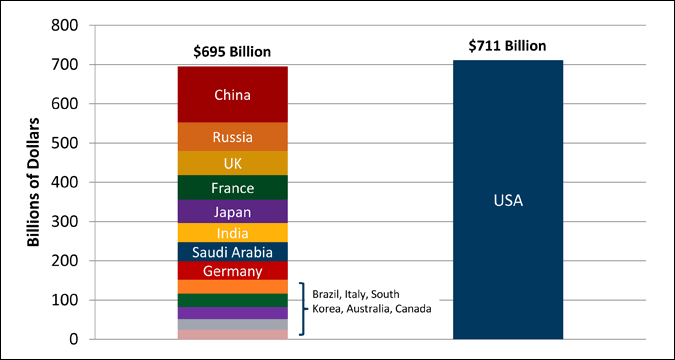This Guest Post is a copy of comments by “Dryly 41” about Why the Economy Isn’t Doomed, an article whose theme is, “challenges have been with us before and have preceded eras of broadly shared prosperity?”
The article starts with the positives, “slowing health-care costs, rising college graduation rates, a shrinking federal budget deficit [and] we’ve finally become aware of just how lousy the past several decades were for the average U.S. worker.” The greatest negative, it says, is intelligent technology from checkout machines to driverless cars that “may bring about profound declines in employment.” But that technology might instead be the greatest positive if more of our workers have “the education to take advantage of these changes.” The conclusion: Economic growth could turn out to be high, its benefits could be felt throughout our society, and “government could promote such growth by spending on infrastructure, education, and research and development.”
There is at this time no prospect that our government will take the indicated action. Dryly 41 has thoughtful things to say about that.
++++++++++++++++++++++++++++++++++++++++++++++++++++++++++++++++
We had banking panic/depressions in 1819, 1837, 1857, 1873, 1884, 1893 and 1907 before The Great Depression. The prevailing approach to finance was “laissez faire”.
The New Deal under FDR put an end to “laissez faire” and adopted a “strict supervision” approach to finance. They kept the 1927 McFadden Act restrictions on interstate branch banking that President Calvin Coolidge signed into law. The purpose of that legislation was two-fold. They wanted to protect small banks form large bank competition. But equally important they wanted to curb the economic and political power of large financial institutions.
The Glass-Steagall Act introduced deposit insurance to curb bank runs that plagued otherwise healthy banks. But they recognized the “moral hazard” that bankers would have with the use of what Louis Brandeis called “other people’s money” with the government guarantee. To deal with the “moral hazard” problem they separated commercial and investment banks, and restricted speculative activities that banks could engage in. To meet the fraud in the stock market they enacted the Securities Act and enforcement legislation.
It worked. At least until Ronald Reagan started the march away from “strict supervision” back to “laissez faire” by deregulating the Savings and Loan banks. Notwithstanding the disaster of 1,000 of some 3.200 S & L banks failing, the march back to “laissez faire” continued on a bi-partisan basis. Clinton, Rubin and Summers, Greenspan with Gramm, Leach and Bliley repealed the “strict supervision” measures designed to deal with “moral hazard” in 1999. Legislation was enacted to repeal the McFadden Act and the Bank Holding Company Act of 1956 restriction on interstate branch banking in 1994, which paved the way for Too Big Too Fail banks.
The 78 years and 11 months between October 1929 and September 2008 was the longest period of financial stability in our history.
So which do you prefer: “strict supervision” or “laissez faire”?
One might be more optimistic if it were recognized that our economic problems were caused by self-inflicted policies and we corrected them.
First: In 1946, the Gross Federal Debt amounted to 121.7% of GDP. The Truman administration reduced it to 71.4%; Eisenhower to 55.2%; Kennedy/Johnson to 38.6%; Nixon/Ford to 35.8%; and Carter to 32.5%.
Then came Ronald Reagan with “supply side” tax cuts. His Budget Director said they were a “Trojan Horse” to reduce the top rates for the wealthy. Inequality began. The class war was declared. Eight years of deficits raised the Debt to 53.1%. Four more years of deficits under Bush I increased it to 66.1%.
Clinton raised taxes, had 4% unemployment, balanced budgets, and reduced the Gross Federal Debt from 66.1% of GDP to 56.4%.
Then Bush II had two rounds of “supply side” tax cuts in 2001 and 2003. V-P Cheney explained to Treasury Secretary Paul O’Neill: “Reagan proved deficits don’t matter.” When O’Neill continued to object over the second round Cheney fired him. Eight years of deficits raised the Gross Federal Debt from 56.4% of GDP to 85.1%, and left a crippled economy.
No mention in the article of “supply side” even though since Washington in 1789 no political party has inflicted this harm on the nation. It was not for some great national purpose like the Revolutionary War, the Civil War, WW I, or, WW II. All those trillions were borrowed to fund tax cuts for the wealthy who were most able to pay their fair share of taxes.
The most mysterious thing is how members of the media call Ronald Reagan and George W. Bush “conservative”. This was the most radical departure from traditional Republican tax and fiscal party in history. There is no way Calvin Coolidge, Herbert Hoover, Andrew W. Mellon and Reagan and Bush II are “conservative”.
We should consign “supply side” to the dust bin of history. It was quite harmful to the nation.
I wish I could be as optimistic as the author. Our political system is broken and it matters.



